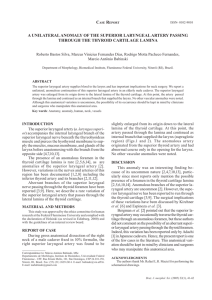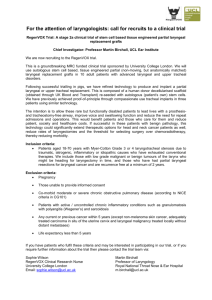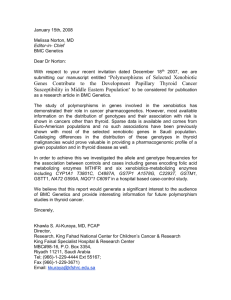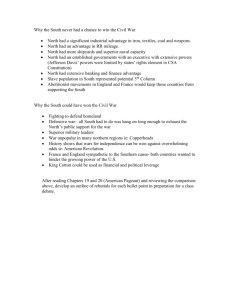Laryngocoele, laryngocele - Vula
advertisement
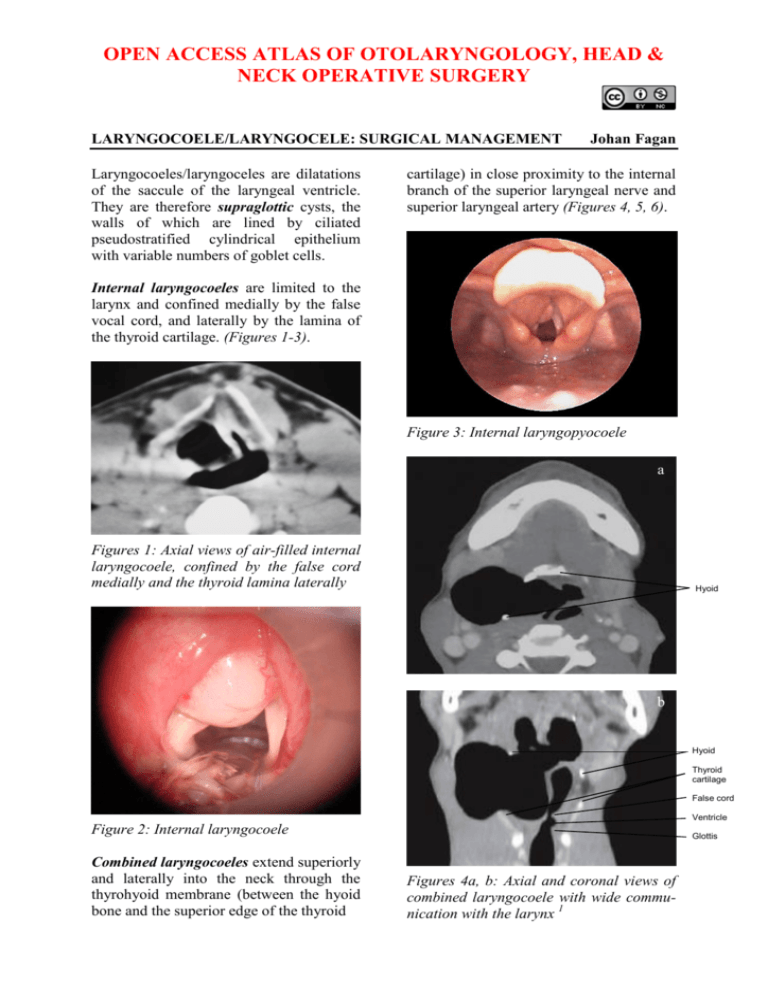
OPEN ACCESS ATLAS OF OTOLARYNGOLOGY, HEAD & NECK OPERATIVE SURGERY LARYNGOCOELE/LARYNGOCELE: SURGICAL MANAGEMENT Laryngocoeles/laryngoceles are dilatations of the saccule of the laryngeal ventricle. They are therefore supraglottic cysts, the walls of which are lined by ciliated pseudostratified cylindrical epithelium with variable numbers of goblet cells. Johan Fagan cartilage) in close proximity to the internal branch of the superior laryngeal nerve and superior laryngeal artery (Figures 4, 5, 6). Internal laryngocoeles are limited to the larynx and confined medially by the false vocal cord, and laterally by the lamina of the thyroid cartilage. (Figures 1-3). Figure 3: Internal laryngopyocoele a Figures 1: Axial views of air-filled internal laryngocoele, confined by the false cord medially and the thyroid lamina laterally Hyoid b Hyoid Thyroid cartilage False cord Ventricle Figure 2: Internal laryngocoele Combined laryngocoeles extend superiorly and laterally into the neck through the thyrohyoid membrane (between the hyoid bone and the superior edge of the thyroid Glottis Figures 4a, b: Axial and coronal views of combined laryngocoele with wide communication with the larynx 1 a Hyoid External sac Internal sac Epiglottis Internal jugular Carotid artery Although not an uncommon incidental postmortem finding, laryngocoeles are generally asymptomatic. Patients may present with voice change or a lateral swelling in the neck overlying the thyrohyoid membrane which may visibly distend when increasing intraluminal pressure e.g. glass blowers and trumpet or reed instrument players (Figures 7a, b). a b Hyoid External sac Internal sac Thyroid cartilage Figures 5 a, b: Fluid-filled combined laryngocoele Laryngocoeles are filled with air when they retain a communication with the laryngeal lumen (Figures 1, 4); when they become isolated from the laryngeal lumen they become fluid-filled (Figures 3, 5) or infected (laryngopyocoele) (Figure 6). b Figure 7a, b: Visible laryngocoeles Patients, especially those with laryngopyocoeles, may present with acute airway obstruction (Figure 6, 8). Occasionally a laryngocoele may be the presenting symptom of laryngeal malignancy obstructing the saccule. Figure 6: Laryngopyocoele causing airway obstruction 2 The thyrohyoid membrane extends between the body and greater cornua of the hyoid bone, and the superior rim of the thyroid cartilage. It is pierced by the internal branch of the superior laryngeal nerve and the superior laryngeal branch of the thyroid artery (Figures 10, 11). Figure 8: Large air-filled laryngocoele obstructing the laryngeal vestibule 2 Surgical Anatomy The saccule or appendix of the ventricle is normally present in most larynges. It arises anteriorly in the ventricle and extends superiorly through the paraglottic space with the ventricular fold (false cord) situated medially and the thyroid lamina laterally (Figure 9). Figure 10: Superior laryngeal nerve, superior laryngeal artery and thyrohyoid membrane Figure 9: Saccule/ appendix of ventricle and course of laryngocoele (yellow arrow) Figure 11: Note how superior laryngeal nerve courses medial to internal carotid artery before piercing the thyrohyoid membrane (green) 3 The superior laryngeal nerve is at risk of injury when resecting a laryngocoele due to its intimate relationship to the external component of the cyst. It arises from the ganglion nodosum of the vagus nerve, descends alongside the pharynx, passes behind the internal carotid artery, and divides into external and internal branches. The internal branch crosses the thyrohyoid membrane and pierces it, accompanied by the superior laryngeal artery, and provides sensory innervation to the larynx (Figure 11). The superior laryngeal artery is encountered during surgery and can either be preserved or sacrificed. It is a branch of the superior thyroid artery (Figure 12). Figure 13: The thyrohyoid, omohyoid and sternomastoid muscles surround the external component of the laryngocoele (thyrohyoid membrane in green) lymphoadenopathy, and a laterally-located thyroglossal duct cyst. An internal laryngocoele can be confused with a carcinoma centered deep in the ventricle which bulges the ventricular fold upwards and medially, and other unusual non-ulcerating masses such as intralaryngeal plasmacytoma, lymphoma and minor salivary gland malignancy. Superior laryngeal artery Figure 12: The superior laryngeal artery branches off the superior thyroid artery The muscles encountered during resection of the external component of a laryngocoele are illustrated in Figure 13. The thyrohyoid muscle is draped over the cyst and may have to be divided; the omohyoid can be retracted anteriorly or divided; and the sternomastoid retracted posteriorly. Imaging The differential diagnosis of a combined laryngocoele includes a branchial cyst, neck abscess, cold abscess (tuberculosis), CT scan will however distinguish between air- and fluid-filled cysts and solid masses. CT evidence of a cyst extending through the thyrohyoid membrane is pathognomonic of a combined laryngocoele. MRI yields similar information. Management This depends on the significance of the symptoms and signs, and the size and extent of the laryngocoele. Laryngoscopy is done to exclude the possibility of underlying malignancy in the larynx. Needle aspiration An acutely inflamed combined cyst may first be aspirated percutaneously with a needle and treated with appropriate anti4 biotics to avoid doing a suboptimal resection in a septic field; needle aspiration may also be employed as an emergency measure to relieve acute airway obstruction. Submandibular gland Internal Laryngocoeles (Figures 1-3) Cyst Small, asymptomatic laryngocoeles do not require surgical intervention. Symptomatic internal laryngocoeles and saccular cysts are widely deroofed/uncapped or excised endoscopically, ideally with CO2 laser. Larger internal laryngocoeles, especially if recurrent, can also be excised by an external approach (see below). Combined Laryngocoeles Omohyoid Figure 15: Expose cyst and define the surrounding structures The surgery is done under general anaesthesia with endotracheal intubation taking care not to rupture the cyst Place a transverse skin incision in a skin crease over the thyrohyoid membrane, from the anterior border of the sternocleidomastoid to the midline of the neck (Figure 14) Using careful sharp and blunt dissecttion, find the dissection plane on the thin cyst wall and identify the superior thyroid (STA) and superior laryngeal arteries (SLA) behind the cyst (Figure 16) Superior thyroid artery (STA) Superior laryngeal artery (SLA) Superior thyroid artery (STA) Figure 16: Expose superior thyroid and superior laryngeal arteries Figure 14: Skin incision over the cyst between hyoid bone and thyroid cartilage Elevate subplatysmal flaps to expose submandibular salivary gland superiorly, omohyoid muscle anteriorly and sternocleidomastoid muscle posteriorly Identify the superior laryngeal nerve (SLN); it emerges deep to the superior thyroid artery (Figure 17) Reflect the cyst upwards, and retract the omohyoid and thinly stretched thyrohyoid muscles anteriorly to expose thyroid lamina. If necessary, transect the thyrohyoid muscle that overlies the cyst for additional exposure (Figure 18) 5 SLN SLA STA Administer 24hrs’ perioperative antibiotics should mucosa be breached Insert a suction/pencil/corrugated drain and close the wound Because mucosal defects would be supraglottic, postoperative surgical emphysema and airway obstruction are unusual Internal cyst Neck External cyst Figure 17: Identify the superior laryngeal nerve (SLN) where it emerges deep to the superior thyroid artery SLA SLN STA Figure 19: Free cyst from the superior laryngeal artery (SLA), superior laryngeal nerve (SLN) and deliver it from paraglottic space Thyroid Thyrohyoid Omohyoid Figure 18: Retract omohyoid and thyrohyoid muscles to expose top edge of thyroid cartilage Free the cyst from the perichondrium on the medial aspect of the thyroid lamina, and deliver it from the paraglottic space. Carefully peel the cyst off the internal branch of the superior laryngeal nerve and from the mucosa overlying the medial aspect of the aryepiglottic fold, and deliver the cyst (Figures 19, 20) Inspect the wound for tears or breaches in the mucosa which, if present, are repaired with absorbable sutures SLN SLA STA Figure 20: Final view of key structures To gain additional exposure to the internal component of the cyst in the paraglottic space Incise the thyroid perichondrium along the superior and posterior margins of the thyroid lamina (Figure 21) 6 Reflect the perichondrium from the lateral aspect of the thyroid lamina with a Freer dissector Remember that the vocal cord is situated midway between the thyroid notch and the lower edge to the thyroid cartilage; therefore make the horizontal cartilage cut above this point Cut through the cartilage with a knife/oscillating saw, taking care not to enter the larynx (Figure 21) Remove and discard the posterosuperior quadrant of the thyroid lamina to gain access to the internal component of the laryngocoele (Figure 22) Following removal of the cyst, suture the perichondrial flap back to its original position Figure 21: Cuts (yellow line) in thyroid cartilage to remove posterosuperior quadrant of thyroid cartilage (green) References 1. Pinho M da C, et al. External laryngocele: sonographic appearance - a case report. Radiol Bras. 2007 Aug [cited 2013 Mar 09]; 40(4):279-82 http://dx.doi.org/10.1590/S010039842007000400015 2. de Paula Felix JA, Felix F, de Mello LFP. Laryngocele: a cause of upper airway obstruction. Rev. Bras. Otorrinolaringol. 2008 Feb [cited 2013 Mar 09]; 74(1): 143-6. http://dx.doi.org/10.1590/S003472992008000100023 Author & Editor Johan Fagan MBChB, FCORL, MMed Professor and Chairman Division of Otolaryngology, University of Cape Town Cape Town South Africa johannes.fagan@uct.ac.za Figure 22: Note how removal of thyroid lamina improves access to internal component of laryngocoele THE OPEN ACCESS ATLAS OF OTOLARYNGOLOGY, HEAD & NECK OPERATIVE SURGERY www.entdev.uct.ac.za The Open Access Atlas of Otolaryngology, Head & Neck Operative Surgery by Johan Fagan (Editor) johannes.fagan@uct.ac.za is licensed under a Creative Commons Attribution - Non-Commercial 3.0 Unported License 7

